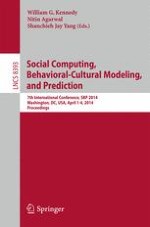This book constitutes the refereed proceedings of the 7th International Conference on Social Computing, Behavioral-Cultural Modeling, and Prediction, SBP 2014, held in Washington, DC, USA, in April 2014. The 51 full papers presented were carefully reviewed and selected from 101 submissions. The SBP conference provides a forum for researchers and practitioners from academia, industry, and government agencies to exchange ideas on current challenges in social computing, behavioral-cultural modeling and prediction, and on state-of-the-art methods and best practices being adopted to tackle these challenges. The topical areas addressed by the papers are social and behavioral sciences, health sciences, military science, and information science.
